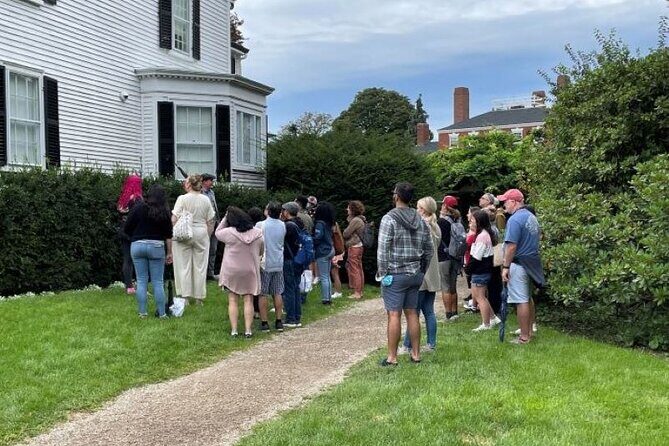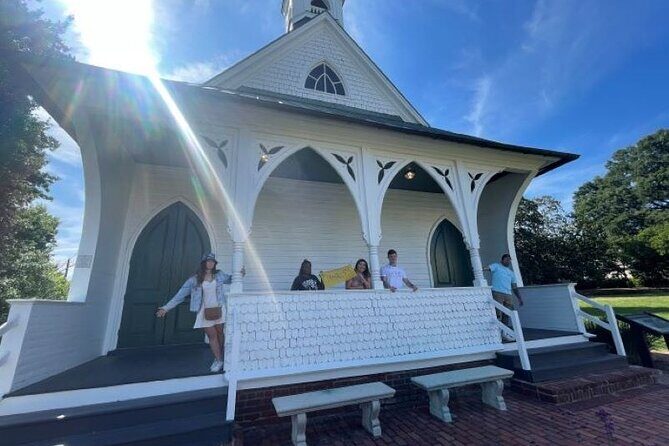We Shall Overcome: A Williamsburg Black History Experience offers an eye-opening journey into the African American story woven into Colonial Williamsburg’s landscape. For just $23.25 per person, you’ll spend around 2 hours walking through historic sites with a knowledgeable guide—perfectly suited for history buffs and curious travelers alike. This tour shines by focusing on untold stories of resilience and contribution, rather than just the usual revolutionary tales, giving you a more authentic view of American history.
Two things we really appreciate about this experience: First, the detailed narrative provided by guides like Vincent, who is praised for his knowledge and passion—you can tell he genuinely wants to share a complete picture, even the uncomfortable truths. Second, the authenticity of the sites visited, from the First Baptist Church graveyard to historic homes, which offers a tangible sense of history.
A possible consideration is that some stops only allow you to view sites from the outside, which might be frustrating if you’re eager to go indoors. Plus, since the tour is mostly outdoor and on foot, it’s good to be prepared for weather and walking conditions.
This tour is great for history enthusiasts, students, or anyone eager to understand the African American experience in colonial Virginia. If you’re interested in stories of resilience, social change, and the often overlooked aspects of American history, this experience will deepen your understanding.
Key Points

- Authentic focus on Black history in Williamsburg, including stories of enslaved people, freed black servants, and pioneering African Americans.
- Expert guides like Vincent, who are praised for their knowledge, compassion, and ability to present sensitive history with honesty.
- Historical sites with meaningful stories, such as the First Baptist Church graveyard and the Mary Stith House with generous bequests to freed black servants.
- Mostly outdoor stops, with some availability for inside visits on select days, so weather and walking pace are considerations.
- Affordable value for the depth of history and emotional impact, especially compared to more typical Williamsburg tours.
- Limited to 20 participants, fostering a more personal and engaging experience.
A Deep Look at the Williamsburg Black History Experience

Embarking on the We Shall Overcome tour is like stepping into a history book you can walk through. Starting at the Kimball Theatre, the tour runs for about 2 hours, led by guides who are not just well-informed but also genuinely passionate about sharing stories that are often left out of traditional narratives. The price of $23.25 is a small investment for such a meaningful exploration—consider it a chance to see Williamsburg through a different lens.
What makes this tour stand out is its focus on the African American experience during colonial times. It’s not just about slavery; it’s about the resilience, contributions, and complex lives of people who are often reduced to mere footnotes. This perspective turns a typical Williamsburg visit into a more balanced, authentic experience.
Interested in history? Here are other past-focused experiences we've examined in Williamsburg
The Itinerary Breakdown
The tour begins at the Historic First Baptist Church, where we learn about its significance in African American religious and community life. If you’re visiting on a Monday, Wednesday, Friday, or Saturday, you might even get to go inside. The churchyard contains graves of enslaved people, with stories that remind us of the mortality and spiritual life of those who faced unimaginable hardships.
Next, outside the Brickhouse Tavern, we learn about the first African American lawyers’ office housed in the building. The story of its owner is a rare glimpse into early black professional achievement, and although we view it from outside, the historical significance remains powerful.
The George Wythe House is another stop that invites reflection. Despite owning slaves, Wythe’s home is significant because of the loyalty of his slaves and the discovery of a plot against him—highlighting the complicated nuances of colonial society and individual relationships.
The Governor’s Palace prompts discussion about Lord Dunmore’s famous proclamation offering freedom to slaves who fought for the British. It’s a pivotal moment that underscores the debate over slavery’s role during the Revolution—a topic that’s often glossed over in simpler tours.
At the Peyton Randolph House, we confront the stark reality that some colonists, including the lady of the house, were not sympathetic to enslaved people. The stories here challenge any sanitized version of colonial life.
The Raleigh Tavern was a political hub, where colonists debated their responses to Dunmore’s proclamation. It’s a window into the internal conflicts of the revolution, with stories of the First Virginia Convention.
Moving on, the Mary Stith House tells an inspiring story of a woman who left her property to her freed black servants—a rare act of kindness and foresight in that era. This part of the tour often prompts feelings of hope and complexity in colonial social relations.
Finally, the Colonial Williamsburg Courthouse reveals the harsh reality of slavery’s legal systems, including the process of selling slaves and recovering fugitive slaves. It’s a sobering, important element of understanding slavery’s grip on colonial society.
Authenticity and Sensitivity
Many reviews mention the knowledge and empathy of the guides, especially Vincent, who is praised for his ability to handle difficult topics with honesty and respect. Some travelers noted that the tour can be emotionally heavy—a sign of its sincerity and depth. For example, one reviewer said, “The subject matter was heavy, sad, and emotionally triggering,” but appreciated the truthfulness and sensitivity of the guide.
There are some limitations; most stops are viewed from the outside, and the tour involves walking and standing, so comfort with outdoor conditions is advisable. Nonetheless, this outdoor focus keeps the experience grounded and tangible.
What the Reviews Reveal
The overwhelmingly positive reviews highlight the expertise and passion of the guides, with many calling the experience “a must-do for history nerds” or “the most memorable part of their Williamsburg visit.” Several reviewers appreciated how the tour included stories of love, hope, and ambition, counteracting the dehumanizing narratives often associated with slavery.
A few reviews mention that the tour can feel emotionally overwhelming, which is a testament to its authenticity. It’s not a lighthearted stroll, but rather a sober reflection on a difficult past. Some guests expressed a desire for more inside visits to historic buildings, which the tour is considering for future improvements.
The Value and Practicalities
At $23.25, this tour is remarkably affordable considering the depth of history and the small group size, which fosters a more personal experience. The mobile ticket makes it easy to join, with a meeting point at Kimball Theatre that’s central in Williamsburg. Since the tour is booked most days about 12 days in advance, planning ahead is recommended.
It’s important to note that transportation isn’t included, so you’ll want to get yourself to the starting point. The tour ends back at the same location, making logistics straightforward for most visitors.
- The Romantic Side of Williamsburg Walking Tour
- Step in Time Inside Historic Buildings of Colonial Williamsburg
- Private Tour of Colonial Williamsburg & Sir Christopher Wren Bldg
- History of Slavery Tour in Williamsburg
- Yorktown Battlefield Self-Guided Driving Tour
- Private tour from Williamsburg to Monticello World Heritage Site
Final Thoughts on We Shall Overcome

This experience stands out as a thoughtful, well-researched tour that brings to light the stories of African Americans in Williamsburg, often overlooked in traditional tours. The knowledgeable guides like Vincent make the experience engaging, compassionate, and authentic. The outdoor nature of the visit emphasizes the living history, making the past feel immediate and real.
If you’re someone who values deep, honest storytelling and wants to understand the complex layers of American history, this tour offers a meaningful perspective. It’s especially suitable for history enthusiasts, students, or visitors seeking a more balanced view of colonial Williamsburg.
While it’s not perfect—some stops only allow external viewing, and the emotional weight may be heavy for some—its strength lies in the truthfulness and respect with which it approaches its subject.
In the end, We Shall Overcome is more than just a tour; it’s a chance to honor the resilience and contributions of those whose stories deserve to be told. For a genuine, impactful history walk that respects its subjects and educates its visitors, this experience is a solid choice.
FAQ
How long does the tour last?
It lasts approximately 2 hours, giving enough time to explore key historic sites without feeling rushed.
What is the cost?
The price is $23.25 per person, which offers good value given the depth of stories and guided expertise.
Where does the tour start?
It begins at the Kimball Theatre in Williamsburg, VA, a convenient, central location.
Are inside visits included?
Some indoor stops are available on certain days (like the First Baptist Church), but most sites are viewed from outside.
Is transportation provided?
No, transportation isn’t included, so you’ll need to make your way to the start point on your own.
What is the group size?
The tour is limited to 20 travelers, ensuring a more personal, engaging experience.
Can I cancel if my plans change?
Yes, the booking is fully refundable if canceled more than 24 hours in advance.
Is the tour suitable for children?
Most travelers can participate, but because of the emotional and historical weight, younger children might find some parts challenging.
Is the tour accessible?
The tour involves walking and outdoor exposure, so accessibility details are not specified, but it’s generally suitable for most able-bodied visitors.
What should I wear or bring?
Comfortable walking shoes and weather-appropriate clothing are recommended, since most stops are outdoors and involve walking.
This tour offers a meaningful way to connect with Williamsburg’s overlooked Black history—and understand a more complete picture of America’s past. We believe it’s especially valuable for those eager for authentic stories, guided by passionate experts who handle delicate topics with care.
More Historical Tours in Williamsburg
More Tour Reviews in Williamsburg
- Scavenger Hunt Adventure in Williamsburg by Zombie Scavengers
- Signature Ride at Upper Shirley Vineyards – 3 hours
- Private Colonial Williamsburg Breakfast – Exploring Before and After Restoration
- Scavenger Hunt Adventure in Williamsburg by Operation City Quest
- Jamestown Settlement American Revolution Museum 7-Day Ticket
- Half-Day Holiday and Tacky Lights Tour in Richmond
More Williamsburg experiences we've covered
- 4 Best Drinking Tours In Williamsburg (With Reviews & Prices)
- Scavenger Hunt Adventure in Williamsburg by Zombie Scavengers
- Signature Ride at Upper Shirley Vineyards – 3 hours
- Private Colonial Williamsburg Breakfast – Exploring Before and After Restoration
- Scavenger Hunt Adventure in Williamsburg by Operation City Quest
- Jamestown Settlement American Revolution Museum 7-Day Ticket
- Half-Day Holiday and Tacky Lights Tour in Richmond
- Colonial Ghosts Boos and Brews Haunted Pub Crawl
- Wacky Williamsburg Scavenger Hunt
- Williamsburgs Winter Wonderland: A Historic Holiday Stroll
- Private Colonial Williamsburg Christmas Holiday Decorations Walking Tour
- Night Watchman’s Ghost Tour
